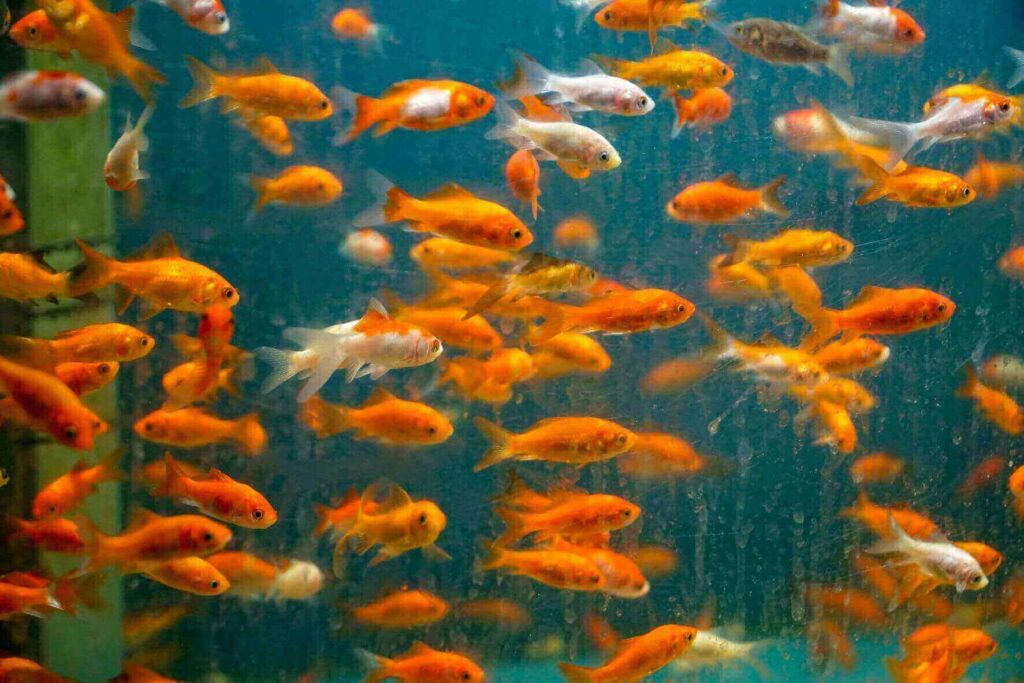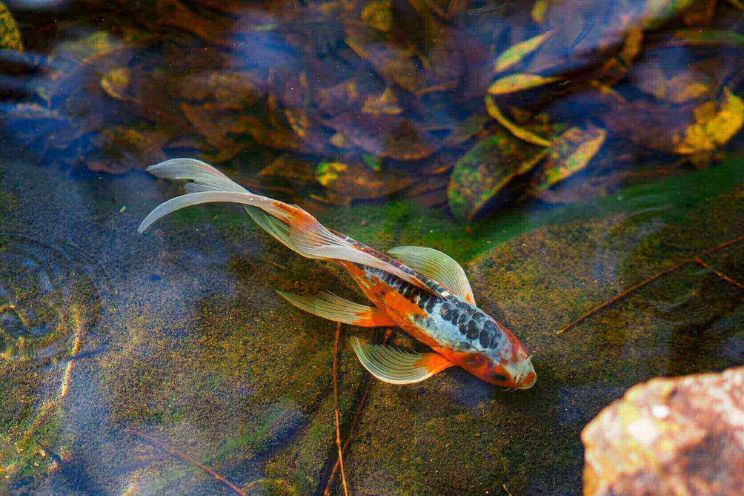Much like us mammals, who can be host to ticks, fleas, lice, leeches and many other nasty parasites, fish also have a range of species which live and feed on them as parasites.
In the wild, fish will always come into contact with parasites, however, in the wild environment, it isn’t as much of a problem as the habitat is large, parasites are few and far between and the fish’s immune system can deal with them in small numbers.
However, in the home aquarium, the habitat is concentrated, parasites can build up quickly and can be of a severe health risk to your fish.
Goldfish can also get parasites, but what do they look like? What do they do and how can I treat them?
We hope to answer these questions below.
What are parasites on goldfish?
Parasites that infect goldfish are usually small invertebrates, like worms and crustaceans.
They come in all different shapes and sizes and affect goldfish in different ways – some of them can be lethal, whereas others are of less threat to the goldfishes’ wellbeing.
Despite what different things they do, all these animals live on the fish, sapping away nutrients, blood or flesh, damaging them and lowering their immunity.
They should be removed from your pet as soon as possible in order to provide the best welfare for your goldfish.
Do fish carry parasites?
By default, fish do not carry parasites; especially goldfish, who are a domestic animal and are only bred in captivity.
Can internal parasites spread to other fish?
However, fish will pick up parasites from their environment and can then carry them and spread them to others. This is usually the case in fish stores as it can be hard to avoid, especially for places who don’t use copper in their water.
Of course, this is not the fault of the store; parasites are unavoidable when keeping thousands of fish together.
How do goldfish get parasites?
There are a few ways in which fish can get parasites:
From Pet Stores

What happens is stores will ship in hundreds of fish from abroad, some of these fish will be wild caught and could have picked up parasites in the wild, or during their time being moved.
The fish carrying these parasites will spread them as they come into contact with other fish – this is commonplace for busy fish stores who move on high amounts of livestock.
As in most stores, the tanks are linked by a sump and all the water is the same – this is to keep the water in better condition, make maintenance easier and make it easier to treat fish.
But, this system comes with the downside of having all the waters contaminated, and a fish from one tank can spread disease to another tank. This way, a goldfish raised in captivity, living in one tank, can pick up parasites from a wild caught fish from a different tank.
This is the most common reason goldfish will have parasites.
From Ponds

Alternatively, fish can also pick parasites up if they are introduced either naturally or artificially, especially if they live in ponds, where they are exposed to wildlife such as birds which can carry parasites in their faeces.
Pond parasites are all the same things you will encounter in your aquarium too, just with a few additions that are commonplace, especially in huge natural ponds.
Leeches can feed on your fish, however, only a couple species actually do this – most leeches are harmless to you and your fish and actually eat worms.
Leeches can be removed by hand and killed with treatments that have copper in them.
How do I know if my goldfish has parasites?
Depending on the species infecting your goldfish, you will be able to tell in different ways. Some species of parasite are external and can easily be spotted on the body of your fish, whereas others are more subtle, and you may only notice a minor change in your goldfish’s behaviour or health.
As mentioned, there are different types of parasites, and there are several that you may commonly come into contact with when keeping fish.
These are:
- Rust/Velvet
- Ichthyophthirius (white spot)
- Intestinal worms
- Anchor worms
- Gill fluke
Below we will discuss symptoms, what they look like, how they are contracted and how to treat them.
Goldfish parasite symptoms
External goldfish parasites
Velvet symptoms: also referred to as the “gold dust” disease, the fish will appear to clamp its fins, become lethargic and stressed and will have a rusty looking coating over part of or its whole body.
Ich (White Spot) symptoms: as its common name suggests, Ich appears as little white spots on your fish’s body. They cause symptoms like irritation and flashing, your fish will be seen scratching their sides on the substrate or against decor, as if they are attempting to scratch off the parasites.
Anchor Worm symptoms: these are easily visible on the body, gills and tail of your
fish. They hang onto the skin of the goldfish and have an appearance like a “Y” shape tag, hanging from your goldfish.
Over a time if the fish has enough of them, they cause lethargy, irritation and rapid gill movement through stress.
Gill Fluke symptoms: noticeable if your fish’s gills are discoloured, the fish seems to be swimming at the surface sucking air, swimming against a current for long periods of time and the fish is breathing rapidly.
Gill flukes can also lead to abrasions, swelling and infections within and around the gills.
Internal goldfish parasites
Goldfish can also get internal parasites like worms.
Intestinal worms in goldfish come in many forms. Much like those that can affect us humans, the most common parasitic worms that affect goldfish are flatworms, roundworms and tapeworms.
Although they aren’t visible on the body of your goldfish, there are symptoms and telltale signs that your goldfish does have internal parasites.
Goldfish parasitic worms are similar to those that can affect humans, in that they live within the intestinal tract, feeding on nutrients that the goldfish passes through its digestive system.
Goldfish Tapeworm symptoms: lethargy, weight loss, stringy white faeces, weakness, discolouration and stress.
Roundworms and Flatworms: affect goldfish and live within the intestines too, and involve similar symptoms to tapeworms; lethargy, stringy white faeces, weakness, loss of colour and sudden weight loss.
What do parasites do to goldfish?
As previously mentioned, each parasite affects goldfish in different ways. Some of these parasites also have complex life cycles, and actually only live on goldfish for a certain time in their life.
Whitespot lives on your goldfish only in its sexually mature stage; the eggs, pupae and larvae live in amongst the gravel. This is why they spread so easily, as they are within the water column and not just localised on the fish’s body.
Whitespot feeds on the skin, protective slime coating and external organs of the fish. This lowers the fish’s immunity. They then become weak and ill – an infestation of white spot can quickly lead to death in goldfish if left untreated.
Velvet is very similar to whitespot in that it lives and feeds on the slime coating of the fish at a specific point in its life, and for the rest of its life, lives in amongst the gravel, decor and filter of your tank. This means that it is spread through the water column, making it highly infectious!
Parasitic worms feed on the flesh or nutrients within a fish’s gut, weakening the fish and causing nutritional deficiencies, or even internal bleeding!
Gill flukes live on the gills of the fish, consuming the membrane and filaments which are used by the fish to absorb oxygen. This damage to the gills causes bleeding, reduced oxygen consumption, suffocation, swelling and ulcers!
Anchor worms cling on the goldfish with tiny hooks and consume the blood of the fish, much like a tick, weakening the goldfish over time.
How to treat goldfish parasites
Luckily, there are many treatments available for parasites, most of these treatments aim to outright kill the parasites and are designed to cover a wide array of species.
This is because many of the treatments include copper, which is toxic to invertebrates. This is also the reason why anti-parasite meds will also kill any snails or shrimp you may have in your tank too, so be careful if you are treating your fish.
How to treat parasites in goldfish
Internal parasites are relatively easy to treat with the use of anti-parasite meds and good maintenance.
How to treat whitespot in goldfish
For goldfish with worms, or parasites like whitespot, velvet and fluke, dose an anti parasite medicine following the instructions on the box, and perform regular deep gravel cleans (for white spot, it is best to do this at night time).
With regular water changes and dosing of anti white spot meds, your fish should clear up within a week or so – be sure to keep on top of this treatment for at least 2 weeks.
The eggs and pupae of many parasites are immune to copper and will persist within the tank for a few days. Once they hatch, another dose of meds will finish them off and your tank will be free from parasites.
How to treat anchor worms on goldfish
For parasites like anchor worms, they can be removed carefully by hand or with tweezers. Just make sure to use gloves when handling your fish, as the oils from your skin are harmful to the fish’s slime coating.
Once the parasite is removed, apply an antiseptic to the area to prevent infection.
You should also then dose anti fluke and parasite meds for the next week or so to get any stragglers or young parasites within the tank.
Can parasites from goldfish transfer to humans when cleaning the tank?
In short, the likelihood of this happening is extremely slim; your fish would have to be carrying parasites which are non-host specific, and can transfer from a fish to a mammal, which isn’t common.
The eggs or larvae would then have to be in the water and you would have to somehow ingest them, either by licking your hands or swallowing the infected water.
Fish are cold blooded animals, which means that their blood is composed of a different protein than ours.
On top of this, the biological difference between a human and a fish is vast, and this makes it very hard for a disease or parasite to pass from a fish to a human and vice versa.
However, if and when this does happen, it is called a zoonotic disease, when a pathogen passes from an animal to a human.
You may be able to pick up roundworms if your fish are infected with them, but again, you’d have to do something silly like drink their aquarium water, and roundworms usually die in the human stomach, or are easily treatable with worm tablets.
Essentially, in the home aquarium, you don’t have much to worry about, but you probably still shouldn’t go around drinking aquarium water…

My goldfish is 27 yrs old. The fish has raised red to pink lesions along, mostly, the right side. They vary in size and are lumpy not smooth. Some of the lesions have a white raised dots. Yesterday two white string like things appeared from one of the lesions. They didn’t move independently but moved with the circulating water. I have been treating with Doxtcycline for septicemia, he has been having a problem with that as he gets older. He is about 10” long and is alone in th tank. The tank is 15gal. I cannot afford a bigger tank. He eats well, fed by hand as he is blind, and is fairly active.